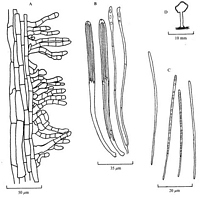|
 Chlorovibrissea bicolor Chlorovibrissea bicolor
SynonymsVibrissea bicolor
BiostatusOccurrence uncertain
Images (click to enlarge)
Caption: Fig. 1. Vibrissea bicolor. (A) Cortex of stalk showing superficial hairs. (B) Asci and paraphyses;
left, ascus with spores in a fascicle; right, ascus with spores throughout length. (C) Four
ascospores. (D) Section of ascoma. |
Article: Beaton, G.W.; Weste, G. (1977). Australian discomycetes: a new Vibrissea species. Transactions of the British Mycological Society 69: 323-325.
Description: Apothecia superficial, stipitate, scattered or in swarms, not confluent, up to 10 mm high;
fertile head subglobose or lobed, to 4 mm diam., yellow when fresh, drying grey-balck and
becoming finely pruinose with extruded ascospores, recovering to slightly darker yellow
when soaked, totally covered with the hymenium except where the stalk is inserted in an
umbilicis; medullary excipulum of loosely-interwoven, long-celled hyphae, to 6 µm thick,
in a gelatinous matrix and merging gradually into the parallel hyphae of the stalk medulla;
stalk to 1 mm thick, tough and rather stiff when fresh, cylindrical with a small mycelial pad
at point of attachment, dark green when fresh, drying black and remaining so, finely scurfy.
Stem composed of two distinct tissues; the medullary tissue a hyaline or pale green textura
porrecta with cells to 60 x 10 µm, the cortical tissue to 180 µm thick, of dark green
pigmented hyphae with cells to 25 x 8 µm and covered with a tomentum of up to 7-celled,
thin-walled, obtuse hairs to 40 x 5 µm, individual cells seldom longer than 8 µm. The
whole ascoma releasing a little yellow-green pigment in 2 % KOH solution. Asci
cylindrical with a tapering stalk, with 8 spores in a fascicle or distributed throughout the
length of the ascus, the small pore J + when soaked in water or 2 % KOH solution, 132-155
x 5-6.5 µm. Ascospores filiform, thinner at one end, with numerous oil drops, no septation
seen, 53-60 x 1.5-2 µm. Paraphyses cylindrical with thicker tips containing one to several
oil drops, septate, branching from the bases, slightly longer than the asci, 1.5 µm thick, tips to 3.5
µm, a very few to 4 µm.
Notes: V. bicolor differs from V. tasmanica in having a yellow head, a dark green, stiff stalk, larger asci
with non-septate ascospores, and in the much shorter and short-celled hairs of the stalk; from V.
melanochlora in not being totally green, in the smaller asci and ascospores and in the thinner tips
to the paraphyses and from V. dura in having green pigmentation and smaller asci and
ascospores. Vibrissea bicolor is the only Victorian species of Vibrissea found so far that fruits
either totally or partially immersed in running water.
|